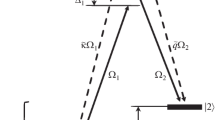Abstract
An analysis is made of the possibility of using kinetic cooling of a gas moving at a low subsonic or supersonic velocity in a field of continuous resonance radiation to produce a medium with population inversion.
Similar content being viewed by others
Literature cited
V. I. Balykin, A. L. Golger, Yu. R. Kolomiiskii, V. S. Letokhov, and O. A. Tumanov, “CO2 laser at 10.6 μm with optical pumping at 9.6 μm,” Pis'ma Zh. Eksp. Teor, Fiz.,19, 482 (1974).
A. D. Wood, M. Camac, and E. T. Gerry, “Effects of 10.6 μ laser induced air chemistry on the atmospheric refractive index,” Appl. Opt.,10, 1877 (1971).
B. F. Gordiets, A. I. Osipov, and R. V. Khokhlov, “Cooling of gas when intense radiation of a CO2 laser passes through the atmosphere,” Zh. Tekh. Fiz.,44, 1063 (1974).
H. Aung and M. Katayama, “Interferometric studies of transient cooling and heating of CO2 induced by 10.6 μ laser pulse and vibration-translation relaxation,” Jpn. J. Appl. Phys.,14, 82 (1975).
V. M. Gordienko, V. A. Gorshkov, V. Ya. Panchenko, and A. P. Sukhorukov, “Kinetic cooling of a mixture of CO2-N2 gases by CO2-laser radiation,” Zh. Eksp. Teor. Fiz.,13, 874 (1977).
A. M. Starik, “Kinetic cooling of moving gases,” Izv. Akad. Nauk SSSR, Mekh. Zhidk. Gaza, No. 3, 127 (1982).
A. Yu. Volkov, A. I. Demin, V. N. Epikhin, E. M. Kudryaetsev, and N. N. Sobolev, “Investigation of a gas-dynamic CS2 laser aimed at increasing the efficiency and extending the spectral range of this type of laser,” Tr. Fiz. Inst. Akad. Nauk SSSR,113, 168 (1979).
V. A. Levin and A. M. Starik, “Vibrational energy transfer in H2O-H2-O2 mixtures in the case of rapid cooling in supersonic nozzles,” Izv. Akad. Nauk SSSR, Mekh. Zhidk. Gaza, No. 2, 101 (1980).
V. A. Levin and A. M. Starik, “On the possibility of generating radiation in the submillimeter range by cooling of a H2O-H2 mixture in supersonic nozzles,” Pis'ma Zh. Tekh. Fiz.,5, 682 (1979).
W. S. Benedict, M. A. Pollack, and W. J. Tomplinson, “The water-vapor laser,” IEEE J. Quantum Electron.,5, 108 (1969).
Author information
Authors and Affiliations
Additional information
Translated from Izvestiya Akademii Nauk SSSR, Mekhanika Zhidkosti i Gaza, No. 5, pp. 139–144, September–October, 1982.
Rights and permissions
About this article
Cite this article
Levin, V.A., Starik, A.M. Population inversion of vibrational levels in the case of kinetic cooling of a moving gas. Fluid Dyn 17, 768–772 (1982). https://doi.org/10.1007/BF01090161
Received:
Issue Date:
DOI: https://doi.org/10.1007/BF01090161



